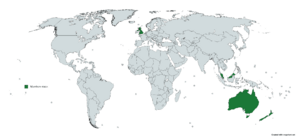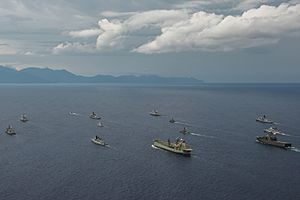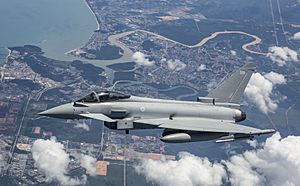Five Power Defence Arrangements facts for kids

Member states shown in dark green
|
|
| Founded | 16 April 1971 |
|---|---|
| Type | Military alliance |
| Headquarters | RMAF Butterworth Air Base Sembawang Air Base |
|
Membership
|
|
The Five Power Defence Arrangements (FPDA) is an agreement between five countries: Australia, Malaysia, New Zealand, Singapore, and the United Kingdom. These countries used to be part of the British Empire and are now members of the Commonwealth. The FPDA was created to help these countries work together on defence matters.
It was signed in 1971. The main idea is that if any of these five countries is threatened or attacked, the others will talk "immediately" about what to do. This agreement is about talking and planning together. It doesn't force any country to send its military to help. Instead, it encourages cooperation and discussion. The FPDA does not cover a country's special economic zones (EEZ). Protecting an EEZ is up to that country.
Contents
History of the FPDA
The FPDA was formed after the United Kingdom decided to remove its armed forces from areas "east of Suez" in 1967. This meant the UK would no longer guarantee to defend Malaya (now part of Malaysia) under an older agreement.
So, in 1971, the FPDA was set up. The five countries agreed to talk right away if any of them faced a military threat or attack. This agreement helps them work together on defence. It also created an Integrated Air Defence System (IADS) for Peninsular Malaysia and Singapore. This system is based at RMAF Butterworth in Malaysia. An Australian Air Vice-Marshal leads it.
RMAF Butterworth was controlled by the Royal Australian Air Force until 1988. Now, the Royal Malaysian Air Force runs it. However, military planes and people from all five FPDA countries still visit and train there regularly.
In 1981, the five countries started holding their first yearly land and sea military exercises. Since 1997, the naval (sea) and air exercises have been combined. The IADS headquarters now includes people from all parts of the military. It helps plan the yearly five-power exercises. These exercises are slowly adding land forces too.
The FPDA also holds important meetings. The FPDA Defence Chiefs' Conference (FDCC) is where the top military leaders meet. The FPDA Ministerial Meeting (FDMM) is where defence ministers meet. These meetings help the countries discuss and share ideas.
In 2016, New Zealand's defence plan stated that it would "meet its commitments" if Malaysia or Singapore were attacked. This shows the strong ties within the FPDA.
40th Anniversary of the FPDA
On November 1, 2011, Singapore hosted the FPDA's 40th anniversary celebration. Defence ministers, aircraft, and military personnel from all five countries gathered at Changi Air Base (East). They took part in a special event.
Later, Singapore's Defence Minister, Ng Eng Hen, hosted a dinner. The defence ministers met with Singapore's Prime Minister, Lee Hsien Loong. They talked about many important topics. A three-day joint exercise, called Exercise Bersama Lima, tested how well the countries could work together. It ended on November 4, 2011.
50th Anniversary of the FPDA
On October 18, 2021, the FPDA celebrated its 50th anniversary. There were joint air and naval displays. Ships and aircraft from the member countries took part. Singapore's Defence Minister and the top diplomats from Australia, Malaysia, New Zealand, and the United Kingdom watched.
Before this, a two-week joint exercise called Exercise Bersama Gold took place. This exercise honored the FPDA's golden jubilee (50th year). It was the first FPDA exercise since the start of the COVID-19 pandemic. About 2,600 military personnel were involved. They did air and sea training exercises. They also had a virtual workshop on jungle warfare.
Ships like the Australian HMAS Canberra and New Zealand's HMNZS Aotearoa took part. The British destroyer HMS Diamond also joined.
Personnel and Facilities
The FPDA countries keep some military personnel and facilities in Malaysia and Singapore to support the agreement.
Australia's Presence
Australia has military personnel and facilities at RMAF Butterworth in Malaysia. These include:
- No. 19 Squadron (19SQN) – This group provides ground support.
- No. 92 Wing Detachment Alpha (92WG Det A) – They operate AP-3C Orions aircraft.
- A training group for the Australian Army.
- A health clinic.
- Rifle Company Butterworth, a unit of the Australian Army.
United Kingdom's Presence
The United Kingdom also has personnel and facilities in Malaysia and Singapore. These include:
- British Defence Singapore Support Unit – This is a naval support base in Sembawang, Singapore. It helps the Royal Navy.
- Staff at the Integrated Area Defence System Headquarters (HQ IADS) at RMAF Butterworth in Penang, Malaysia. These staff members help coordinate air defence.
FPDA Military Exercises
Since it began, the FPDA has held many joint military exercises. All five member countries take part. Singapore and Malaysia take turns leading these exercises.
These exercises started in the 1970s as simple air defence drills. In the 1980s, land and sea exercises were added. Now, they happen every year and are more complex. They combine air, sea, and land forces. They practice responding to both traditional and new types of threats. Most exercises happen off the coast of Malaysia and Singapore. Some have also taken place in the South China Sea. Countries not part of the FPDA are often invited to watch these drills.
Here are some examples of FPDA exercises:
- Exercise Bersatu Lima – This was the first major exercise, held in 1972.
- Exercise Platypus – The first land-based FPDA exercise. It was held in Australia in 1981.
- Exercise Starfish – One of the first FPDA naval exercises, started in 1981. It has been replaced by Exercise Bersama Lima.
- Exercise Suman Warrior – A land-based exercise that began in the 1990s. It takes place in Australia and New Zealand.
- Exercise Flying Fish – The first exercise that combined air, sea, and land forces. It was first held in 1997. The first one was very large, with 39 warships and 160 combat aircraft.
- Exercise Bersama Padu – This name means "Together United" in Malay. The first one in 2006 involved 21 warships, 85 aircraft, 1 submarine, and ground forces.
- Exercise Suman Protector – Started in 2007. It is held every five years as a big final exercise in the FPDA's training cycle.
- Exercise Bersama Shield – This used to be the main air defence exercise until 2004.
- Exercise Bersama Lima – This name means "Together Five" in Malay. These exercises started in 2004 and happen every year.
- Exercise Bersama Gold – This exercise replaced Exercise Bersama Lima in October 2021. It was held to mark the FPDA's 50th anniversary.






